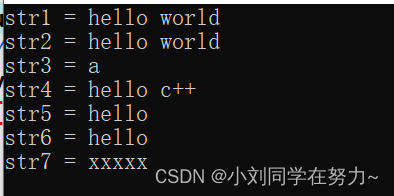目录
1. string基本概念
本质:
-
string是C++风格的字符串,而string本质上是一个类
特点:
使用string容器时须写#include <string> 头文件
string 类内部封装了很多成员方法
例如:查找find,拷贝copy,删除delete 替换replace,插入insert,由于方法比较多,这里就主要介绍几个常用的操作
string管理char*所分配的内存,不用担心复制越界和取值越界等,由类内部进行负责
2. string构造函数
构造函数原型:
string(); //创建一个空的字符串 例如: string str;
string(const char* s); //使用字符串s初始化
string(const string& str); //使用一个string对象初始化另一个string对象
string(int n, char c); //使用n个字符c初始化示例:
#include <string>
//string构造
void test01()
{
string s1; //创建空字符串,调用无参构造函数
cout << "str1 = " << s1 << endl;
const char* str = "hello world";
string s2(str); //把c_string转换成了string
cout << "str2 = " << s2 << endl;
string s3(s2); //调用拷贝构造函数
cout << "str3 = " << s3 << endl;
string s4(10, 'a');
cout << "str3 = " << s3 << endl;
}
int main() {
test01();
return 0;
}总结:string的多种构造方式没有可比性,灵活使用即可
3 .string赋值操作
string的赋值操作主要分为两种,operator和assign,operator最常用
-
string& operator=(const char* s);//char*类型字符串 赋值给当前的字符串 -
string& operator=(const string &s);//把字符串s赋给当前的字符串 -
string& operator=(char c);//字符赋值给当前的字符串 -
string& assign(const char *s);//把字符串s赋给当前的字符串 -
string& assign(const char *s, int n);//把字符串s的前n个字符赋给当前的字符串 -
string& assign(const string &s);//把字符串s赋给当前字符串 -
string& assign(int n, char c);//用n个字符c赋给当前字符串
示例:
//赋值
void test01()
{
str1 = "hello world";
cout << "str1 = " << str1 << endl;
string str2;
str2 = str1;
cout << "str2 = " << str2 << endl;
string str3;
str3 = 'a';
cout << "str3 = " << str3 << endl;
string str4;
str4.assign("hello c++");
cout << "str4 = " << str4 << endl;
string str5;
str5.assign("hello c++",5);
cout << "str5 = " << str5 << endl;
string str6;
str6.assign(str5);
cout << "str6 = " << str6 << endl;
string str7;
str7.assign(5, 'x');
cout << "str7 = " << str7 << endl;
}
int main() {
test01();
return 0;
}运行结果:

4. string字符串拼接
函数原型:
-
string& operator+=(const char c);//重载+=操作符 -
string& operator+=(const string& str);//重载+=操作符 -
string& append(const char *s);//把字符串s连接到当前字符串结尾 -
string& append(const char *s, int n);//把字符串s的前n个字符连接到当前字符串结尾 -
string& append(const string &s, int pos, int n);//字符串s中从pos开始的n个字符连接到字符串结尾
示例:
//字符串拼接
void test01()
{
string str1 = "我";
str1 += "爱玩游戏";
cout << "str1 = " << str1 << endl;
str1 += ':';
cout << "str1 = " << str1 << endl;
string str2 = "LOL DNF";
str1 += str2;
cout << "str1 = " << str1 << endl;
string str3 = "I";
str3.append(" love ");
str3.append("game abcde", 4);
//str3.append(str2);
str3.append(str2, 4, 3); // 从下标4位置开始 ,截取3个字符,拼接到字符串末尾
cout << "str3 = " << str3 << endl;
}
int main() {
test01();
return 0;
}运行结果:

5. string查找和替换
功能描述:
-
查找:查找指定字符串是否存在
-
替换:在指定的位置替换字符串
函数原型:
-
int find(const string& str, int pos = 0) const;//查找str第一次出现位置,从pos开始查找 -
int rfind(const string& str, int pos = npos) const;//查找str最后一次位置,从pos开始查找 -
string& replace(int pos, int n, const string& str);//替换从pos开始n个字符为字符串str -
string& replace(int pos, int n,const char* s);//替换从pos开始的n个字符为字符串s
示例:
//查找和替换
void test01()
{
//查找
string str1 = "abcdefgde";
int pos = str1.find("de");
if (pos == -1){
cout << "未找到" << endl;
}else
{
cout << "pos = " << pos << endl;
}
pos = str1.rfind("de");
cout << "pos = " << pos << endl;
}
void test02()
{
//替换
string str1 = "abcdefgde";
str1.replace(1, 3, "1111");
cout << "str1 = " << str1 << endl;
}
int main() {
test01();
test02();
return 0;
}运行结果:

总结:
-
find查找是从左往后,rfind从右往左
-
find找到字符串后返回查找的第一个字符位置,找不到返回-1
-
replace在替换时,要指定从哪个位置起,多少个字符,替换成什么样的字符串
6 .string字符串比较
比较方式:
字符串比较是按字符的ASCII码进行对比 :
- = 返回 0
- > 返回 1
- < 返回 -1
函数原型:
-
int compare(const string &s) const;//与字符串s比较 -
int compare(const char *s) const;//与字符串s比较
示例:
//字符串比较
void test01()
{
string s1 = "hello";
string s2 = "aello";
int ret = s1.compare(s2);
if (ret == 0) {
cout << "s1 等于 s2" << endl;
}else if (ret > 0){
cout << "s1 大于 s2" << endl;
}else{
cout << "s1 小于 s2" << endl;
}
}总结:字符串对比主要是用于比较两个字符串是否相等,判断谁大谁小的意义并不是很大
7 .string字符存取
string中单个字符存取方式有两种,两种基本一直,推荐使用第一种
-
char& operator[](int n);//通过[]方式取字符 -
char& at(int n);//通过at方法获取字符
示例:
void test01()
{
string str = "hello world";
for (int i = 0; i < str.size(); i++)
{
cout << str[i] << " ";
}
cout << endl;
for (int i = 0; i < str.size(); i++)
{
cout << str.at(i) << " ";
}
cout << endl;
//字符修改
str[0] = 'x';
str.at(1) = 'x';
cout << str << endl;
}8 .string插入和删除
函数原型:
-
string& insert(int pos, const string& str);//插入字符串 -
string& erase(int pos, int n = npos);//删除从Pos开始的n个字符
示例:
//字符串插入和删除
void test01()
{
string str = "hello";
str.insert(1, "111");
cout << str << endl;
str.erase(1, 3); //从1号位置开始3个字符
cout << str << endl;
}总结:插入和删除的起始下标都是从0开始
9 .string子串
函数原型:
-
string substr(int pos = 0, int n = npos) const;//返回由pos开始的n个字符组成的字符串
示例:
//子串
void test01()
{
string str = "abcdefg";
string subStr = str.substr(1, 3);
cout << "subStr = " << subStr << endl;
string email = "hello@sina.com";
int pos = email.find("@");
string username = email.substr(0, pos);
cout << "username: " << username << endl;
}




















 182
182











 被折叠的 条评论
为什么被折叠?
被折叠的 条评论
为什么被折叠?








